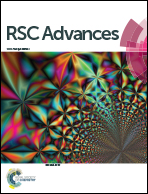Investigation of the thermal decomposition and stability of energetic 1,2,4-triazole derivatives using a UV laser based pulsed photoacoustic technique
Abstract
This paper is in continuation of our previous report which was based on a 532 nm wavelength pulsed photoacoustic (PA) technique with nitro rich energetic materials named 1-(4-methyl-3,5-dinitrophenyl)-1H-1,2,4-triazole (p-Me-DNPT), 1-(4-methoxy-3,5-dinitrophenyl)-1H-1,2,4-triazole (p-OMe-DNPT), and 2,6-dinitro-4-(1H-1,2,4-triazol-1-yl) aniline (p-NH2-DNPT) in the 30–350 °C temperature range. In the present work, the PA fingerprint spectra, thermal stability and efficiency of these compounds as rocket fuel have been evaluated using the fourth harmonic i.e. 266 nm wavelength of 7 ns pulse duration and 10 Hz repetition rate as an excitation source. The entire study is based on the photodissociation process due to the π* ← n electronic transition in NO2 molecules which is initiated inside the PA cell. The result obtained from the PA technique and thermogravimetric-differential thermal analysis (TG-DTA) data confirm the multistep decomposition mechanism. The study also provides the stable thermal quality factor “Q” which is linked to the stability of the compound.


 Please wait while we load your content...
Please wait while we load your content...